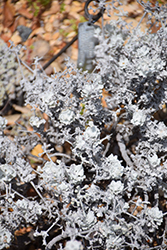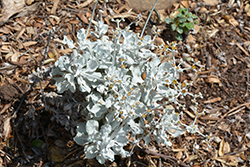It's all about ...
plants

Height: 18 inches
Spread: 30 inches
Sunlight:
![]()
![]()
Hardiness Zone: 9a
Other Names: Conejo Buckwheat
Description:
An attractive, compact plant for use in water-wise applications and xeriscaping; a native shrub producing chartreuse to yellow flowers above silver-white foliage in late spring; blooms fade to copper and persist until fall; excellent for naturalizing
Ornamental Features
Saffron Buckwheat features showy clusters of yellow flowers with chartreuse overtones rising above the foliage from late spring to mid fall, which emerge from distinctive brick red flower buds. The flowers are excellent for cutting. Its attractive tomentose oval leaves emerge white in spring, turning grayish green in colour with distinctive white veins and tinges of silver the rest of the year.
Landscape Attributes
Saffron Buckwheat is a dense multi-stemmed evergreen perennial with a mounded form. Its relatively fine texture sets it apart from other garden plants with less refined foliage.
This is a relatively low maintenance plant, and should only be pruned after flowering to avoid removing any of the current season's flowers. It is a good choice for attracting bees and butterflies to your yard. It has no significant negative characteristics.
Saffron Buckwheat is recommended for the following landscape applications;
- Mass Planting
- Rock/Alpine Gardens
- Border Edging
- General Garden Use
- Groundcover
- Naturalizing And Woodland Gardens
- Container Planting
Planting & Growing
Saffron Buckwheat will grow to be about 18 inches tall at maturity, with a spread of 30 inches. Its foliage tends to remain dense right to the ground, not requiring facer plants in front. Although it is technically a woody plant, this plant can be expected to behave as a perennial in our climate if planted outdoors over the winter, usually regrowing from its base (crown) the following year. As such, gardeners should take into consideration that it will perform differently than it would in its native habitat.
This plant does best in full sun to partial shade. You may want to keep it away from hot, dry locations that receive direct afternoon sun or which get reflected sunlight, such as against the south side of a white wall. It prefers dry to average moisture levels with very well-drained soil, and will often die in standing water. It is considered to be drought-tolerant, and thus makes an ideal choice for a low-water garden or xeriscape application. It is not particular as to soil pH, but grows best in poor soils. It is highly tolerant of urban pollution and will even thrive in inner city environments. This species is native to parts of North America.
Saffron Buckwheat is a fine choice for the garden, but it is also a good selection for planting in outdoor pots and containers. It is often used as a 'filler' in the 'spiller-thriller-filler' container combination, providing a mass of flowers and foliage against which the thriller plants stand out. Note that when growing plants in outdoor containers and baskets, they may require more frequent waterings than they would in the yard or garden. Be aware that in our climate, most plants cannot be expected to survive the winter if left in containers outdoors, and this plant is no exception. Contact our experts for more information on how to protect it over the winter months.
This plant is not reliably hardy in our region, and certain restrictions may apply; contact the store for more information.

